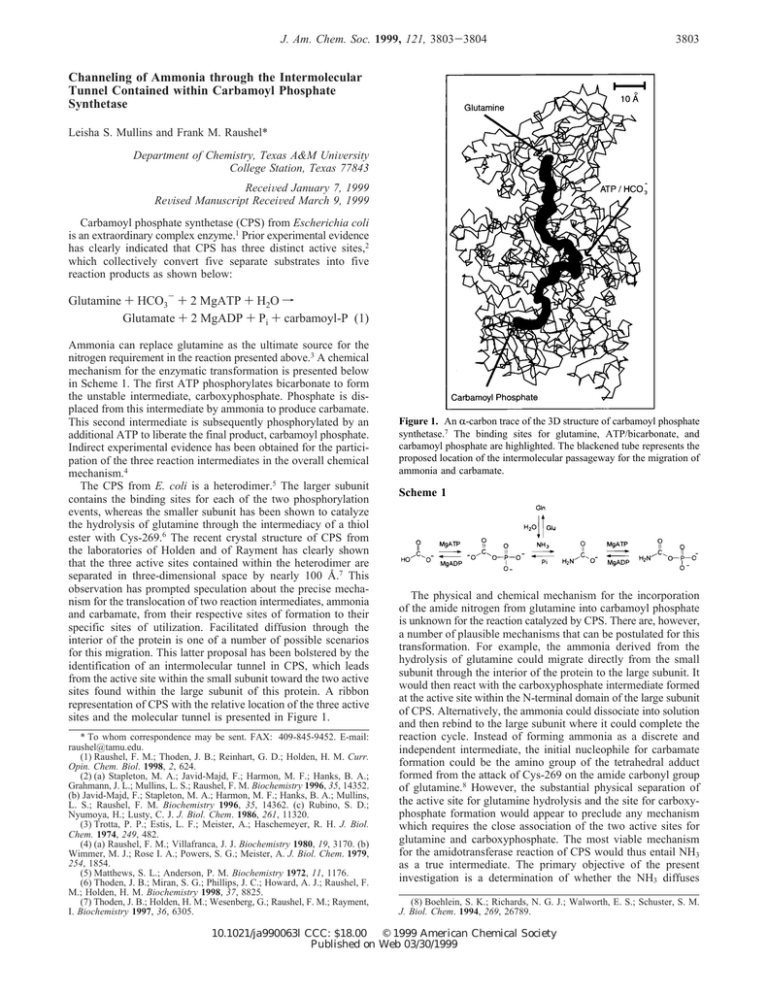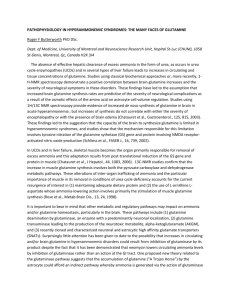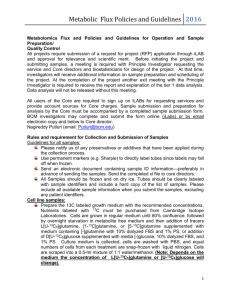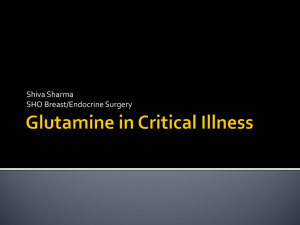Channeling of Ammonia through the Intermolecular Tunnel Contained within Carbamoyl Phosphate Synthetase
advertisement

J. Am. Chem. Soc. 1999, 121, 3803-3804 3803 Channeling of Ammonia through the Intermolecular Tunnel Contained within Carbamoyl Phosphate Synthetase Leisha S. Mullins and Frank M. Raushel* Department of Chemistry, Texas A&M UniVersity College Station, Texas 77843 ReceiVed January 7, 1999 ReVised Manuscript ReceiVed March 9, 1999 Carbamoyl phosphate synthetase (CPS) from Escherichia coli is an extraordinary complex enzyme.1 Prior experimental evidence has clearly indicated that CPS has three distinct active sites,2 which collectively convert five separate substrates into five reaction products as shown below: Glutamine + HCO3- + 2 MgATP + H2O f Glutamate + 2 MgADP + Pi + carbamoyl-P (1) Ammonia can replace glutamine as the ultimate source for the nitrogen requirement in the reaction presented above.3 A chemical mechanism for the enzymatic transformation is presented below in Scheme 1. The first ATP phosphorylates bicarbonate to form the unstable intermediate, carboxyphosphate. Phosphate is displaced from this intermediate by ammonia to produce carbamate. This second intermediate is subsequently phosphorylated by an additional ATP to liberate the final product, carbamoyl phosphate. Indirect experimental evidence has been obtained for the participation of the three reaction intermediates in the overall chemical mechanism.4 The CPS from E. coli is a heterodimer.5 The larger subunit contains the binding sites for each of the two phosphorylation events, whereas the smaller subunit has been shown to catalyze the hydrolysis of glutamine through the intermediacy of a thiol ester with Cys-269.6 The recent crystal structure of CPS from the laboratories of Holden and of Rayment has clearly shown that the three active sites contained within the heterodimer are separated in three-dimensional space by nearly 100 Å.7 This observation has prompted speculation about the precise mechanism for the translocation of two reaction intermediates, ammonia and carbamate, from their respective sites of formation to their specific sites of utilization. Facilitated diffusion through the interior of the protein is one of a number of possible scenarios for this migration. This latter proposal has been bolstered by the identification of an intermolecular tunnel in CPS, which leads from the active site within the small subunit toward the two active sites found within the large subunit of this protein. A ribbon representation of CPS with the relative location of the three active sites and the molecular tunnel is presented in Figure 1. * To whom correspondence may be sent. FAX: 409-845-9452. E-mail: raushel@tamu.edu. (1) Raushel, F. M.; Thoden, J. B.; Reinhart, G. D.; Holden, H. M. Curr. Opin. Chem. Biol. 1998, 2, 624. (2) (a) Stapleton, M. A.; Javid-Majd, F.; Harmon, M. F.; Hanks, B. A.; Grahmann, J. L.; Mullins, L. S.; Raushel, F. M. Biochemistry 1996, 35, 14352. (b) Javid-Majd, F.; Stapleton, M. A.; Harmon, M. F.; Hanks, B. A.; Mullins, L. S.; Raushel, F. M. Biochemistry 1996, 35, 14362. (c) Rubino, S. D.; Nyumoya, H.; Lusty, C. J. J. Biol. Chem. 1986, 261, 11320. (3) Trotta, P. P.; Estis, L. F.; Meister, A.; Haschemeyer, R. H. J. Biol. Chem. 1974, 249, 482. (4) (a) Raushel, F. M.; Villafranca, J. J. Biochemistry 1980, 19, 3170. (b) Wimmer, M. J.; Rose I. A.; Powers, S. G.; Meister, A. J. Biol. Chem. 1979, 254, 1854. (5) Matthews, S. L.; Anderson, P. M. Biochemistry 1972, 11, 1176. (6) Thoden, J. B.; Miran, S. G.; Phillips, J. C.; Howard, A. J.; Raushel, F. M.; Holden, H. M. Biochemistry 1998, 37, 8825. (7) Thoden, J. B.; Holden, H. M.; Wesenberg, G.; Raushel, F. M.; Rayment, I. Biochemistry 1997, 36, 6305. Figure 1. An R-carbon trace of the 3D structure of carbamoyl phosphate synthetase.7 The binding sites for glutamine, ATP/bicarbonate, and carbamoyl phosphate are highlighted. The blackened tube represents the proposed location of the intermolecular passageway for the migration of ammonia and carbamate. Scheme 1 The physical and chemical mechanism for the incorporation of the amide nitrogen from glutamine into carbamoyl phosphate is unknown for the reaction catalyzed by CPS. There are, however, a number of plausible mechanisms that can be postulated for this transformation. For example, the ammonia derived from the hydrolysis of glutamine could migrate directly from the small subunit through the interior of the protein to the large subunit. It would then react with the carboxyphosphate intermediate formed at the active site within the N-terminal domain of the large subunit of CPS. Alternatively, the ammonia could dissociate into solution and then rebind to the large subunit where it could complete the reaction cycle. Instead of forming ammonia as a discrete and independent intermediate, the initial nucleophile for carbamate formation could be the amino group of the tetrahedral adduct formed from the attack of Cys-269 on the amide carbonyl group of glutamine.8 However, the substantial physical separation of the active site for glutamine hydrolysis and the site for carboxyphosphate formation would appear to preclude any mechanism which requires the close association of the two active sites for glutamine and carboxyphosphate. The most viable mechanism for the amidotransferase reaction of CPS would thus entail NH3 as a true intermediate. The primary objective of the present investigation is a determination of whether the NH3 diffuses (8) Boehlein, S. K.; Richards, N. G. J.; Walworth, E. S.; Schuster, S. M. J. Biol. Chem. 1994, 269, 26789. 10.1021/ja990063l CCC: $18.00 © 1999 American Chemical Society Published on Web 03/30/1999 3804 J. Am. Chem. Soc., Vol. 121, No. 15, 1999 Communications to the Editor 15N Figure 2. 15N NMR spectra of 15N-labeled citrulline. (A) 15N-labeled citrulline produced in the absence of added glutamine and with [15N]NH4+ as the only nitrogen source. (B) 15N-labeled citrulline produced when 25 mM unlabeled glutamine was allowed to compete with 100 mM [15N]-NH4+ as the source of nitrogen. directly through the interior of the heterodimer to the large subunit or dissociates into the bulk solution and then rebinds to another active site. No current experimental evidence is available that clearly demonstrates the direct channeling of ammonia between the two subunits of CPS. In an effort to investigate the mechanism of transfer for ammonia from the small subunit to the large subunit of CPS, a competition between the ammonia derived from the hydrolysis of glutamine and exogenous 15NH3/NH4+ added to the bulk solvent was investigated by NMR spectroscopy. The two alternative mechanisms for ammonia transfer can potentially be distinguished by allowing 15NH3 added to the bulk solvent to compete with unlabeled NH3 derived from the hydrolysis of glutamine during the formation of carbamoyl phosphate. If the ammonia derived from the hydrolysis of glutamine equilibrated with the ammonia from the bulk solution, then the ratio of 15N/ 14N within the product carbamoyl-P would be nearly identical to the initial relative concentrations of 15NH4+ and unlabeled glutamine. Alternatively, if there is no equilibration of ammonia from these two sources, then the ratio of 15N/14N would be dictated by the ratio of kcat/Km for NH4+ and glutamine. In the competition experiments, the formation of carbamoyl phosphate was coupled to the production of citrulline by ornithine transcarbamoylase in order to have a more stable product for NMR analysis. Each reaction mixture contained 100 mM KCl, 10 mM ATP, 15 mM MgCl2, 50 mM HCO3-, 100 mM HEPES, pH 7.6, 25 mM glutamine, 100 mM 15NH4Cl, 25 mM ornithine, 25 mM phosphoenolpyruvate, 50 units of pyruvate kinase, and 50 units of ornithine transcarbamoylase in a final volume of 2.0 mL. The reactions were started with the addition of 1 mg of purified CPS.9 The first control reaction contained no CPS, whereas the second contained no added glutamine. The extent of substrate turnover was measured by quantitation of the citrulline concentration before and after quenching the reaction by passage through an Amicon Centricon filter. In the absence of added glutamine, 12.6 ( 1.1 µmoles of citrulline was formed at the end of the incubation period.10 The 15N NMR spectrum showed the presence of only two resonances: the signals for the remaining 15NH4+ at 0 ppm and the amide nitrogen for the newly formed citrulline at 53.6 ppm (Figure 2A).11 This latter resonance integrated to 6.3 ( 0.2% of the total (9) Mareya, S. M.; Raushel, F. M. Biochemistry 1994, 33, 2945. (10) The rate of formation of citrulline determined in the coupled enzyme assay was determined by the method described by Snodgrass, P. J.; Parry, D. J. J. Lab. Clin. Med. 1969, 73, 940. signal observed in this spectrum. Within experimental error, this value corresponds to the signal expected for the newly formed citrulline since all of the carbamoyl phosphate produced in the absence of glutamine must be formed entirely from the 15N-labeled NH4+/NH3. Therefore, NMR spectroscopy can be used to quantify the 15N/14N ratio in the citrulline, providing that the total citrulline concentration is known by other methods. In the presence of added glutamine, an average of 17.5 ( 2.1 µmoles of citrulline were formed during the reaction period. When glutamine was present during the incubation period, the observed 15 N resonance for citrulline integrated to an average of 0.42 ( 0.13% of the total 15N label present (Figure 2B). This corresponds to 0.84 µmoles of 15N-labeled citrulline in the total pool. Thus, the percentage of 15N found within the citrulline, produced in the presence of added ammonia and glutamine, is 4.8 ( 1.5%. If the NH3 derived from the hydrolysis of glutamine can fully equilibrate with the 15NH3 present in the bulk solvent, then the incorporation of 15N into the final product, citrulline, should have been a minimum of 80%. The observed value is clearly much smaller than what is expected via a dissociation-reassociation mechanism for ammonia transfer. However, if the NH3 derived from glutamine is protected from solvent exchange, then the ratio of 15N/14N within the newly formed citrulline should closely parallel the ratio of the kcat/Km values for NH4+ and glutamine after a correction is made for the relative concentrations of glutamine and NH4+ in the initial incubation mixture. The kcat/Km value for glutamine was determined to be 5.4 × 106 M-1 min-1, whereas that of NH4+ was found to be 2.6 × 103 M-1 min-1.12 If correction is made for the initial concentration of glutamine (25 mM) and NH4+ (100 mM), then the expected initial ratio of citrulline formation from these two substrates, when added simultaneously, would be 520. However, this ratio would drop as the glutamine concentration is depleted in preference to the utilization of ammonia. These considerations give an 15N incorporation from 15NH Cl of ∼0.2%. However, the natural abundance of 15N is 4 0.4% (from glutamine) giving a combined value of ∼0.6%. The experimental results clearly show that the NH3 derived from the hydrolysis of glutamine is not in full equilibrium with bulk solvent but is sequestered and channeled directly to the large subunit. When ammonia and glutamine are used together in direct competition, the incorporation of 15N from the labeled ammonia is less than 5%. If the ammonia, derived from the hydrolysis of glutamine, was functionally able to equilibrate with the ammonia present in the bulk solvent, then the observed 15N incorporation should have been greater than 80%. However, the observed value is slightly greater than the ratio predicted on the basis of the kcat/ Km values for glutamine and ammonia alone. The most likely explanation for the difference between the observed and theoretical values can be rationalized by an assumption of a minor uncoupling of the partial reactions taking place on the small and large subunits of CPS. It is likely that nearly all members of the amidotransferase family of enzymes will utilize a molecular tunnel for the delivery of ammonia from the site of production to the site of utilization. A channel with a somewhat different molecular architecture has already been identified in glutamine phosphoribosyl pyrophosphate amidotransferase by Zalkin and Smith.13 Acknowledgment. This work was supported in part by the National Institutes of Health (DK 30343). JA990063L (11) 15N NMR spectra were obtained on a Varian Unity 500 multinuclear spectrometer operating at a frequency of 50.7 MHz. Typical acquisition parameters were 1.28 s acquisition time, 45 s recycle time, 30° pulse width, and 4000 transients. (12) The kinetic constants were determined by measuring ATP hydrolysis with a pyruvate kinase and lactate dehydrogenase coupled reaction.9 (13) Krahn, J. M.; Kim, J. M.; Burns, M. R.; Parry, R. J.; Zalkin, H.; Smith, J. L. Biochemistry 1998, 36, 111061.




